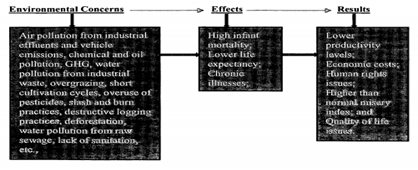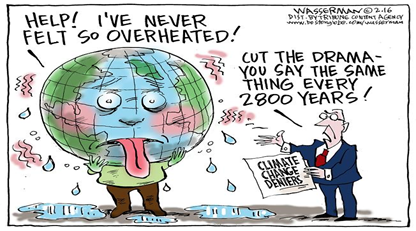Authors: YOGESH KUMAR, RAJ SINGH, KARAN CHHABRA and KULDEEP JANGID
Department of Agricultural Meteorology, 1Department of Genetics and Plant Breeding
College of Agriculture (COA), CCS Haryana Agricultural University, Hisar-125004, Haryana, India
Genesis of Environmental crisis
Environmental Crisis are the crisis leads to increase in demands on diminishing resources, demands accelerates as the population grows and increasing production of wastes. However, by stressing an approach to the environment that attempted to isolate the real problems, declining the amenities of a trivializing discourse, both the counterpoint with the public debate and the underlying presence of “environmental problems” were made obvious. Many of the themes of environmental history inevitably examine the circumstances that produced the environmental problems of the present day, a litany of themes that challenge global sustainability including: population, consumerism and materialism, climate change, waste disposal, deforestation and loss of wilderness, global warming etc.
Environmental issues facing India
Some of the major environmental concerns confronting India include:
- Air pollution from industrial effluents and vehicle emissions
- Energy-related environmental problems such as, chemical & oil pollution and Greenhouse Gas (GHGs) emissions. Water pollution from raw sewage, the lack of adequate sanitation, and nonpotable water throughout the country
- Over-population and its strain on natural resources
- Agricultural factors such as, runoff of agricultural pesticides, overgrazing, short cultivation cycles, slash and burn practices, destructive logging practices, and deforestation of timber reserves for fuel

Figure 1; A Schematic Representation of the Environmental Issues in India
Current Environmental Issues
It is high time for human beings to take the ‘right’ action towards saving the earth from major environmental issues.
There are significant current environmental issues, where human beings play an important role in its cause:-
- Climate change: The average temperature in many regions has been increasing in recent decades. The global average surface temperature has increased by 0.6° + 0.2° Cover the last century. Episodes of El Niño, which creates great storms, have been more frequent, persistent and intense since mid-1970s compared with the previous 100 years. All these are signs that the earth is sick. Its climate is changing, making it more difficult for mankind to survive. The earth is losing its ability to balance itself due to the imbalances created by human activities. Projections of future climate change are derived from a series of experiments made by computer based global climate models. These studies have shown that in the near future, the global mean surface temperature will rise by 1.4° to 5.8°C. Warming will be greatest over land areas, and at high latitudes. The projected rate of warming is greater than has occurred in the last 10,000 years. The frequency of weather extremes is likely to increase leading to floods or drought. There will be fewer cold spells but more heat waves. The frequency and intensity of El Niño is likely to increase. Global mean sea level is projected to rise by 9 to 88 cm by the year 2100. More than half of the world’s population now lives within 60km of the sea. Some of the most vulnerable regions are the Nile delta in Egypt, the Ganges-Brahmaputra delta in Bangladesh, and many small islands including the Marshall Islands and the Maldives, (WHO, 2001).

Figure 2; A Schematic Representation of the Environmental Climate change
- Global warming: About 75% of the solar energy reaching the Earth is absorbed on the earth’s surface which increases its temperature. The rest of the heat radiates back to the atmosphere. Some of the heat is trapped by greenhouse gases, mostly carbon dioxide. As carbon dioxide is released by various human activities, it is rapidly increasing. This is causing global warming. The average surface temperature is about 15°C. This is about 33°C higher than it would be in the absence of the greenhouse effect. Without such gases most of the Earth’s surface would be frozen with a mean air temperature of -18°C. Human activities during the last few decades of industrialization and population growth have polluted the atmosphere to the extent that it has begun to seriously affect the climate. Carbon dioxide in the atmosphere has increased by 31% since pre-industrial times, causing more heat to be trapped in the lower atmosphere. There is evidence to show that carbon dioxide levels are still increasing. Many countries have signed a convention to reduce greenhouse gases under the United Nations Convention on Climate Change. Current international agreements are however not still effective to prevent the significant changes in climate and a rise in sea levels.
- Acid rain: When fossil fuels such as coal, oil and natural gas are burned, chemicals like sulfur dioxide and nitrogen oxides are produced. These chemicals react with water and other chemicals in the air to form sulfuric acid, nitric acid and other harmful pollutants like sulfates and nitrates. These acid pollutants spread upwards into the atmosphere, and are carried by air currents, to finally return to the ground in the form of acid rain, fog or snow. The corrosive nature of acid rain causes many forms of environmental damage. The acids in acid rain chemically react with any object they come in contact with. Acids react with other chemicals by giving up hydrogen atoms. Effects: Acid rain is known to cause widespread environmental damage.
- Ozone layer depletion: Ozone is formed by the action of sunlight on oxygen. It forms a layer 20 to 50kms above the surface of the earth. This action takes place naturally in the atmosphere, but is very slow. Ozone is a highly poisonous gas with a strong odour. It is a form of oxygen that has three atoms in each molecule. It is considered a pollutant at ground level and constitutes a health hazard by causing respiratory ailments like asthma and bronchitis. It also causes harm to vegetation and leads to a deterioration of certain materials like plastic and rubber. Ozone in the upper atmosphere however, is vital to all life as it protects the earth from the sun’s harmful ultraviolet radiation. The ozone layer in the upper atmosphere absorbs the sun’s ultraviolet radiation, preventing it from reaching the earth’s surface. This layer in the atmosphere protects life on earth from the dangerous UV radiation from the sun. In the 1970s, scientists discovered that chemicals called chlorofluorocarbons or CFCs, which were used as refrigerants and aerosol spray propellants, posed a threat to the ozone layer. The CFCs molecules are virtually indestructible until they reach the stratosphere, where UV radiation breaks them down to release chlorine atoms. The chlorine atoms react with ozone molecules which break down into oxygen molecules, which do not absorb UV radiations. Since the early 1980s, scientists detected a thinning of the ozone layer in the atmosphere above Antarctica. This phenomenon is now being detected in other places as well including Australia. Although the use of CFCs has been reduced and now banned in most countries, other chemicals and industrial compounds such as bromine, halocarbons and nitrous oxides from fertilizers may also attack the ozone layer.
- Nuclear Accidents: Nuclear energy was researched and discovered by man as a source of alternate energy which would be clean and cheap compared to fossil fuels. And although this did happen, along with the benefits of nuclear energy came its downfalls. In the short history of nuclear energy there have been accidents that have surpassed any natural calamity or other energy source extraction in their impacts. A single nuclear accident can cause loss of life, long-term illness and destruction of property on a large scale for a long period of time. Radioactivity and radioactive fallout leads to cancer, genetic disorders and death in the affected area for decades after, thus affecting all forms of life for generations to come.
- Overpopulation: This is a never-ending human tragedy which is responsible for causing all types of environmental issues. Water pollution, resources crisis, gender imbalance, pollution, land pollution, urban sprawling, deforestation, over production are some common examples of dangerous effects cause by overpopulation . Despite efforts taken by the government in terms of family planning in many countries, over population is difficult to control at international level. This has become more like a subjective concern and no method seems to be 100% efficient to resolve the problem of over population.
- Deforestation: With population growing at a rapid pace, the demand for food, shelter and cloth has almost tripled in last few decades. To overcome growing demand, a direct action that we have come to recognize as “ Deforestation ” occurs. Deforestation means, clearing of forests or green cover for means of agriculture, industrial or urban use. It involves permanent end of forest cover to make that land available for residential, commercial or industrial purpose. According to the United Nations Food and Agriculture Organization (FAO), an estimated 18 million acres (7.3 million hectares) of forest are lost each year. The long term effects of deforestation can be severely devastating and alarming as they may cause floods, soil erosion, increase in global warming, climate imbalance, wildlife extinction and other serious environmental issues.
- Pollution: More than half of the human population knows what is pollution, but we are still not ready to face its damaging consequences. Pollution is not only limited to water, soil and noise but has extended to light, visual, point and non-point sources. Human beings and their actions are majorly responsible for causing all types of pollution. Water pollution is essentially cause by oil spills, urban runoff and ocean dumping. Air pollution rises from burning of fossil fuels, hydraulic fracturing and gases emitted by vehicles. Water and soil pollution are majorly cause from industrial waste.
Degradation of the environment threatens health both directly and indirectly; and both immediately and in the long term. The environmental problems we most easily observe are those with immediate and direct effects. People—and mostly the poorest and the marginalized—get sick from drinking polluted water, eat contaminated food, suffer from exposure to polluted air and poisonous chemicals, and spend much of their time in harmful working conditions. People’s health suffers in immediate and indirect ways from, for example, food shortages caused by the environmental degradation of both farmland and forests. Environmental refugees—people who have been forced to leave their homes because of the destruction of their local environment—often suffer severe hardships and are prone to ill health. Many people are also being killed or maimed in wars fought over scarce natural resources. Accidents resulting from environmentally induced natural disasters, such as floods caused by the destruction of forests, are another example of the immediate and indirect effects of environmental degradation.
Many environmental threats to health havedirect, long-term (delayed) effects about which awareness may be slow to develop. For example, cancer is increasing rapidly in all areas of the world, largely as a result of exposure to pesticides, carcinogenic chemical substances included in the goods we consume, and increased exposure to various forms of radiation. These threats concern every person on the planet, although we might not even know what is making us sick and where it is coming from. Toxic substances accumulate in our bodies and are mixed in new and potentially lethal ways. Ill health may result several decades after exposure. Yet, the possibleindirect effects of environmental change in the long term may pose some of the most alarming threats to human health. The disturbance of the world’s climate due to enhanced global warming is already underway and may cause severe damage to health. Indeed, since the beginning of agriculture many human societies seem to have perished as a result of overwhelming environmental problems caused by over-use and pollution of natural resources.
About Author / Additional Info:
It is about environmental crisis.